Urban-Induced Changes on Local Circulation in Complex Terrain: Central Mexico Basin
Abstract
:1. Introduction
2. Materials and Methods
2.1. Terrain and Observational Data
2.2. Case Study and Synoptic-Scale Conditions
2.3. WRF Modeling System
2.4. Model Configuration
2.5. Control and Hypothesis Testing Experiments
2.6. Model Parameterization Tests
3. Results and Discussion
3.1. CTRL Simulation
3.1.1. UHI Intensity, and Humidity
3.1.2. Near-Surface Wind Field, Wind Convergence Lines, and Ozone Measurements
4. Urban Effects on Circulation and MSE
5. Summary and Conclusions
Supplementary Materials
Author Contributions
Funding
Data Availability Statement
Acknowledgments
Conflicts of Interest
Abbreviations
| agl | above ground level |
| amsl | above mean sea level |
| B | Bias |
| CONACyT | Mexican National Council for Science and Technology |
| CTRL | Control experiment |
| DCP | Dryland cropland and pasture |
| ECMWF | European Centre for Medium-Range Weather Forecasts |
| ERA 5 | ECMWF Reanalysis v5 |
| GRF | Ground Flux |
| INEGI | National Institute of Statistics and Geography |
| LHF | Latent Heat Flux |
| LST | Local standard time |
| LULC | Land Use Land Cover |
| MODIS | Resolution Imaging Spectroradiometer |
| MSE | Moist Static Energy |
| NATX | Natural vegetation experiment |
| SN1 | south-north transect at 98.87° W |
| SN2 | south-north transect at 99.06° W |
| PBL | Planetary Boundary Layer |
| ppm | parts per million |
| R | Correlation Coefficient |
| RAS | Radiosonde |
| RAWP | Radar Wind profiler |
| RMSE | Root Mean Square Error |
| RNET | Net Radiation |
| SEDEMA | Atmospheric Monitoring Agency of Mexico City |
| SHF | Sensible Heat Fluxes |
| SMN | Servicio Meteorológico Nacional |
| UE | Urban Effect |
| UHI | Urban Heat Island |
| UNAM | Universidad Nacional Autónoma de México |
| URBX | Urban experiment |
| USGS | U.S. Geological Survey |
| VEGX | Vegetated experiment |
| WE1 | West-East transect at 19.43°N |
| WRF | Weather Research and Forecasting |
References
- Miao, S.; Chen, F.; LeMone, M.A.; Tewari, M.; Li, Q.; Wang, Y. An observational and modeling study of characteristics of urban heat island and boundary layer structures in Beijing. J. Appl. Meteorol. Climatol. 2009, 48, 484–501. [Google Scholar] [CrossRef]
- Ganbat, G.; Baik, J.J.; Ryu, Y.H. A numerical study of the interactions of urban breeze circulation with mountain slope winds. Theor. Appl. Climatol. 2015, 120, 123–135. [Google Scholar] [CrossRef]
- Wang, D.; Miao, J.; Zhang, D.L. Numerical simulations of local circulation and its response to land cover changes over the Yellow Mountains of China. J. Meteorol. Res. 2015, 29, 667–681. [Google Scholar] [CrossRef]
- Rendón, A.M.; Salazar, J.F.; Palacio, C.A.; Wirth, V. Temperature inversion breakup with impacts on air quality in urban valleys influenced by topographic shading. J. Appl. Meteorol. Climatol. 2015, 54, 302–321. [Google Scholar] [CrossRef]
- Ding, Y.; Peng, J. Impacts of urbanization of mountainous areas on resources and environment: Based on ecological footprint model. Sustainability 2018, 10, 765. [Google Scholar] [CrossRef] [Green Version]
- Edgerton, S.A.; Bian, X.; Doran, J.; Fast, J.D.; Hubbe, J.M.; Malone, E.L.; Shaw, W.J.; Whiteman, C.D.; Zhong, S.; Arriaga, J.; et al. Particulate air pollution in Mexico City: A collaborative research project. J. Air Waste Manag. Assoc. 1999, 49, 1221–1229. [Google Scholar] [CrossRef] [PubMed] [Green Version]
- Pielke, R.A. Land use and climate change. Science 2005, 310, 1625–1626. [Google Scholar] [CrossRef] [Green Version]
- Bornstein, R.D. Observations of the urban heat island effect in New York City. J. Appl. Meteorol. Climatol. 1968, 7, 575–582. [Google Scholar] [CrossRef]
- Bornstein, R. Mean diurnal circulation and thermodynamic evolution of urban boundary layers. Model. Urban Bound. Layer 1987, 53–93. [Google Scholar]
- Oke, T. The heat island of the urban boundary layer: Characteristics, causes and effects. In Wind Climate in Cities; Springer: Dordrecht, The Netherlands, 1995; pp. 81–107. [Google Scholar]
- Zak, M.; Nita, I.A.; Dumitrescu, A.; Cheval, S. Influence of synoptic scale atmospheric circulation on the development of urban heat island in Prague and Bucharest. Urban Clim. 2020, 34, 100681. [Google Scholar] [CrossRef]
- Beck, C.; Straub, A.; Breitner, S.; Cyrys, J.; Philipp, A.; Rathmann, J.; Schneider, A.; Wolf, K.; Jacobeit, J. Air temperature characteristics of local climate zones in the Augsburg urban area (Bavaria, southern Germany) under varying synoptic conditions. Urban Clim. 2018, 25, 152–166. [Google Scholar] [CrossRef]
- Półrolniczak, M.; Kolendowicz, L.; Majkowska, A.; Czernecki, B. The influence of atmospheric circulation on the intensity of urban heat island and urban cold island in Poznań, Poland. Theor. Appl. Climatol. 2017, 127, 611–625. [Google Scholar] [CrossRef] [Green Version]
- Jauregui, E. Mexico City’s urban Heat Island revisited (die Wärmeinsel von Mexico City—Ein Rückblick). Erdkunde 1993, 47, 185–195. [Google Scholar] [CrossRef]
- Jauregui, E. Heat island development in Mexico City. Atmos. Environ. 1997, 31, 3821–3831. [Google Scholar] [CrossRef]
- Cui, Y.Y.; De Foy, B. Seasonal variations of the urban heat island at the surface and the near-surface and reductions due to urban vegetation in Mexico City. J. Appl. Meteorol. Climatol. 2012, 51, 855–868. [Google Scholar] [CrossRef]
- Klaus, D.; Jauregui, E.; Poth, A.; Stein, G.; Voss, M. Regular Circulation Structures in the Tropical Basin of Mexico City as a Consequence of the Urban Heat Island Effect (Regelhafte Zirkulationsstrukturen im tropischen Hochbecken von Mexiko Stadt als Folge des Wärmeinseleffektes). Erdkunde 1999, 231–243. [Google Scholar] [CrossRef]
- Jazcilevich, A.D.; García, A.R.; Ruíz-Suárez, L.G. A study of air flow patterns affecting pollutant concentrations in the Central Region of Mexico. Atmos. Environ. 2003, 37, 183–193. [Google Scholar] [CrossRef]
- Jazcilevich, A.D.; García, A.R.; Caetano, E. Locally induced surface air confluence by complex terrain and its effects on air pollution in the valley of Mexico. Atmos. Environ. 2005, 39, 5481–5489. [Google Scholar] [CrossRef]
- Whiteman, C.; Zhong, S.; Bian, X.; Fast, J.; Doran, J. Boundary layer evolution and regional-scale diurnal circulations over the and Mexican plateau. J. Geophys. Res. Atmos. 2000, 105, 10081–10102. [Google Scholar] [CrossRef]
- de Foy, B.; Caetano, E.; Magana, V.; Zitácuaro, A.; Cárdenas, B.; Retama, A.; Ramos, R.; Molina, L.; Molina, M. Mexico City basin wind circulation during the MCMA-2003 field campaign. Atmos. Chem. Phys. 2005, 5, 2267–2288. [Google Scholar] [CrossRef] [Green Version]
- de Foy, B.; Clappier, A.; Molina, L.; Molina, M. Distinct wind convergence patterns in the Mexico City basin due to the interaction of the gap winds with the synoptic flow. Atmos. Chem. Phys. 2006, 6, 1249–1265. [Google Scholar] [CrossRef] [Green Version]
- Doran, J.; Zhong, S. Thermally driven gap winds into the Mexico City basin. J. Appl. Meteorol. 2000, 39, 1330–1340. [Google Scholar] [CrossRef]
- Kimura, F.; Kuwagata, T. Thermally induced wind passing from plain to basin over a mountain range. J. Appl. Meteorol. Climatol. 1993, 32, 1538–1547. [Google Scholar] [CrossRef]
- Lau, E.; McLaughlin, S.; Pratte, F.; Weber, B.; Merritt, D.; Wise, M.; Zimmerman, G.; James, M.; Sloan, M. The DeTect Inc. RAPTOR VAD-BL radar wind profiler. J. Atmos. Ocean. Technol. 2013, 30, 1978–1984. [Google Scholar] [CrossRef]
- Skamarock, W.C.; Klemp, J.B.; Dudhia, J.; Gill, D.O.; Liu, Z.; Berner, J.; Wang, W.; Powers, J.G.; Duda, M.G.; Barker, D.M.; et al. A Description of the Advanced Research WRF Model Version 4; National Center for Atmospheric Research: Boulder, CO, USA, 2019; p. 145. [Google Scholar]
- Hersbach, H.; Bell, B.; Berrisford, P.; Hirahara, S.; Horányi, A.; Muñoz-Sabater, J.; Nicolas, J.; Peubey, C.; Radu, R.; Schepers, D.; et al. The ERA5 global reanalysis. Q. J. R. Meteorol. Soc. 2020, 146, 1999–2049. [Google Scholar] [CrossRef]
- Iacono, M.J.; Delamere, J.S.; Mlawer, E.J.; Shephard, M.W.; Clough, S.A.; Collins, W.D. Radiative forcing by long-lived greenhouse gases: Calculations with the AER radiative transfer models. J. Geophys. Res. Atmos. 2008, 113. [Google Scholar] [CrossRef]
- Hong, S.Y.; Lim, J.O.J. The WRF single-moment 6-class microphysics scheme (WSM6). Asia-Pac. J. Atmos. Sci. 2006, 42, 129–151. [Google Scholar]
- Hong, S.Y.; Noh, Y.; Dudhia, J. A new vertical diffusion package with an explicit treatment of entrainment processes. Mon. Weather Rev. 2006, 134, 2318–2341. [Google Scholar] [CrossRef] [Green Version]
- Hong, S.Y. A new stable boundary-layer mixing scheme and its impact on the simulated East Asian summer monsoon. Q. J. R. Meteorol. Soc. 2010, 136, 1481–1496. [Google Scholar] [CrossRef]
- Chen, F.; Dudhia, J. Coupling an advanced land surface–hydrology model with the Penn State–NCAR MM5 modeling system. Part I: Model implementation and sensitivity. Mon. Weather Rev. 2001, 129, 569–585. [Google Scholar] [CrossRef] [Green Version]
- Sertel, E.; Robock, A.; Ormeci, C. Impacts of land cover data quality on regional climate simulations. Int. J. Climatol. 2010, 30, 1942–1953. [Google Scholar] [CrossRef]
- López-Espinoza, E.D.; Zavala-Hidalgo, J.; Gomez-Ramos, O. Weather forecast sensitivity to changes in urban land covers using the WRF model for central Mexico. Atmósfera 2012, 25, 127–154. [Google Scholar]
- He, J.; Yu, Y.; Yu, L.; Liu, N.; Zhao, S. Impacts of uncertainty in land surface information on simulated surface temperature and precipitation over China. Int. J. Climatol. 2017, 37, 829–847. [Google Scholar] [CrossRef]
- Kirthiga, S.; Patel, N. Impact of updating land surface data on micrometeorological weather simulations from the WRF model. Atmósfera 2018, 31, 165–183. [Google Scholar] [CrossRef] [Green Version]
- Rivera-Martínez, S.L. Análisis del Uso de Suelo y Vegetación en México entre 1968 y 2011 para su Uso en un Modelo de Pronóstico Meteorológico; Technical Report; Universidad Nacional Autónoma de México: Ciudad de México, Mexico, 2018. [Google Scholar]
- Holton, J.; Hakim, G. An Introduction to Dynamic Meteorology; Elsevier Academic Press: Waltham, MA, USA, 2013. [Google Scholar]
- Benson-Lira, V.; Georgescu, M.; Kaplan, S.; Vivoni, E. Loss of a lake system in a megacity: The impact of urban expansion on seasonal meteorology in Mexico City. J. Geophys. Res. Atmos. 2016, 121, 3079–3099. [Google Scholar] [CrossRef]
- Li, H.; Wolter, M.; Wang, X.; Sodoudi, S. Impact of land cover data on the simulation of urban heat island for Berlin using WRF coupled with bulk approach of Noah-LSM. Theor. Appl. Climatol. 2018, 134, 67–81. [Google Scholar] [CrossRef]
- Mellor, G.L.; Yamada, T. A hierarchy of turbulence closure models for planetary boundary layers. J. Atmos. Sci. 1974, 31, 1791–1806. [Google Scholar] [CrossRef] [Green Version]
- Mellor, G.L.; Yamada, T. Development of a turbulence closure model for geophysical fluid problems. Rev. Geophys. 1982, 20, 851–875. [Google Scholar] [CrossRef] [Green Version]
- Nakanishi, M.; Niino, H. An improved Mellor–Yamada level-3 model with condensation physics: Its design and verification. Bound. Layer Meteorol. 2004, 112, 1–31. [Google Scholar] [CrossRef]
- Nakanishi, M.; Niino, H. An improved Mellor–Yamada level-3 model: Its numerical stability and application to a regional prediction of advection fog. Bound. Layer Meteorol. 2006, 119, 397–407. [Google Scholar] [CrossRef]
- Angevine, W.M.; Jiang, H.; Mauritsen, T. Performance of an eddy diffusivity–mass flux scheme for shallow cumulus boundary layers. Mon. Weather Rev. 2010, 138, 2895–2912. [Google Scholar] [CrossRef] [Green Version]
- Rendón, A.M.; Salazar, J.F.; Palacio, C.A.; Wirth, V.; Brötz, B. Effects of urbanization on the temperature inversion breakup in a mountain valley with implications for air quality. J. Appl. Meteorol. Climatol. 2014, 53, 840–858. [Google Scholar] [CrossRef]
- Stull, R.B. An Introduction to Boundary Layer Meteorology; Springer Science & Business Media: Dordrecht, The Netherlands, 1988; Volume 13. [Google Scholar]
- Rendón, A.M.; Salazar, J.F.; Wirth, V. Daytime air pollution transport mechanisms in stable atmospheres of narrow versus wide urban valleys. Environ. Fluid Mech. 2020, 20, 1101–1118. [Google Scholar] [CrossRef]
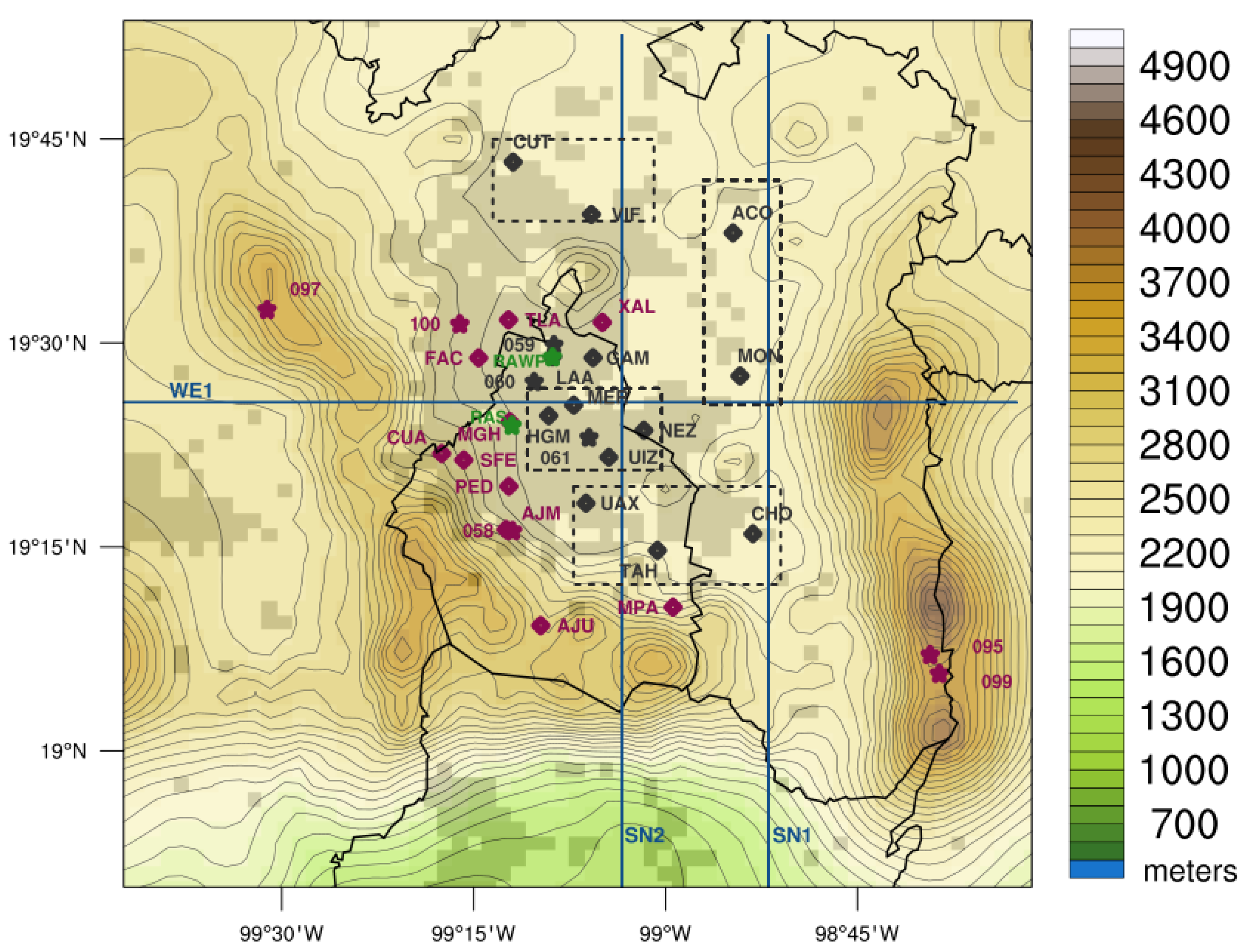
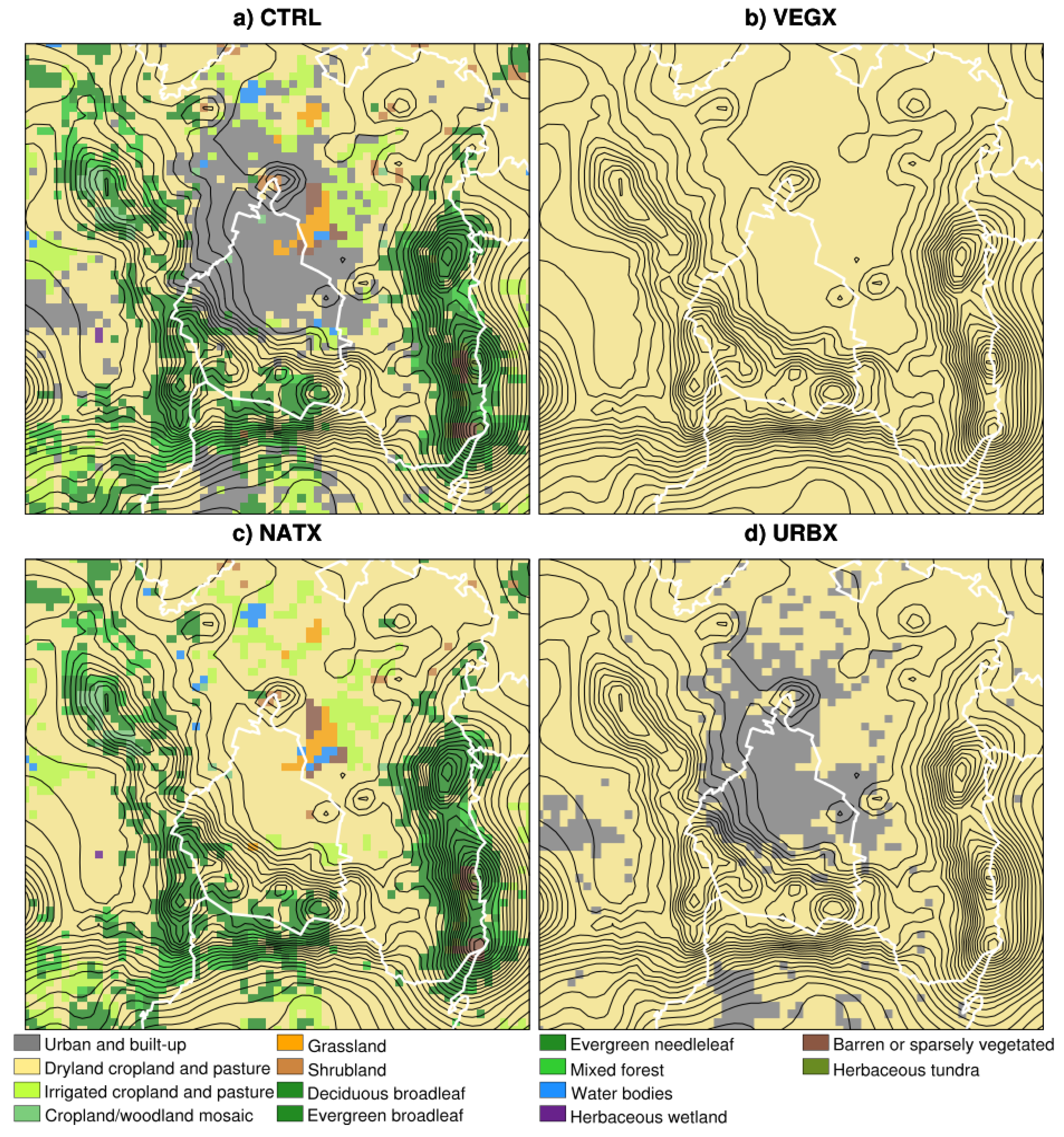
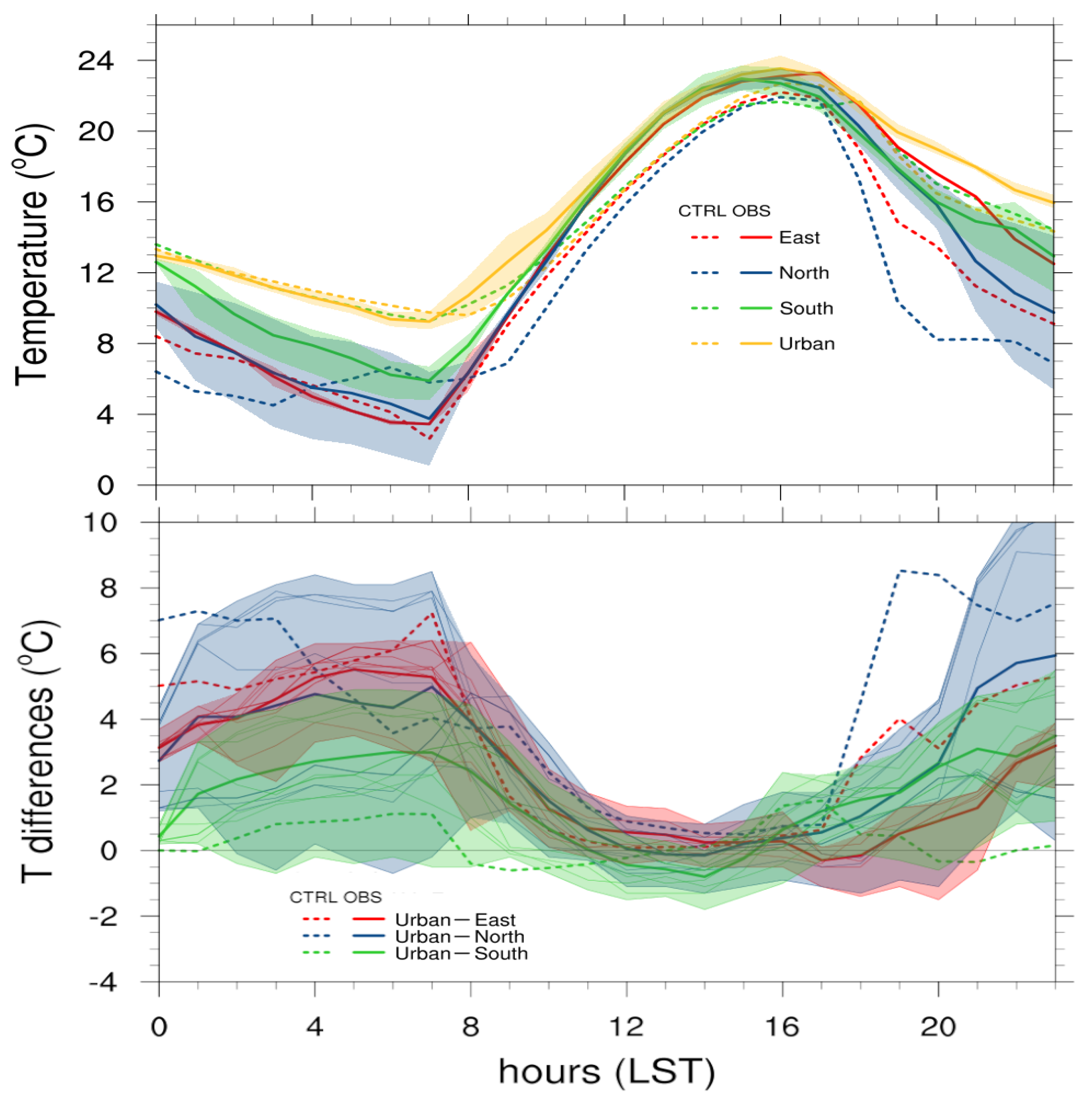
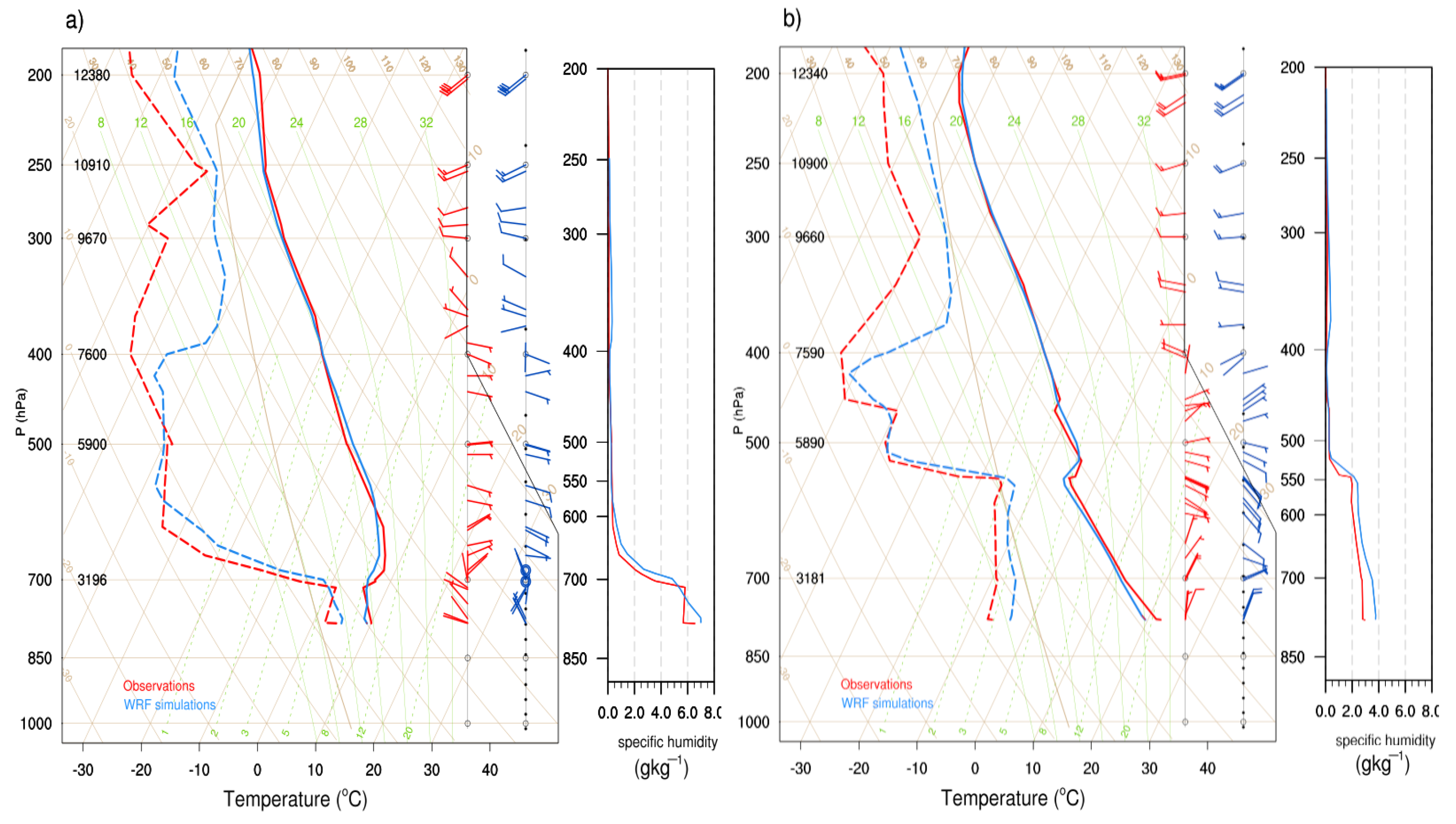
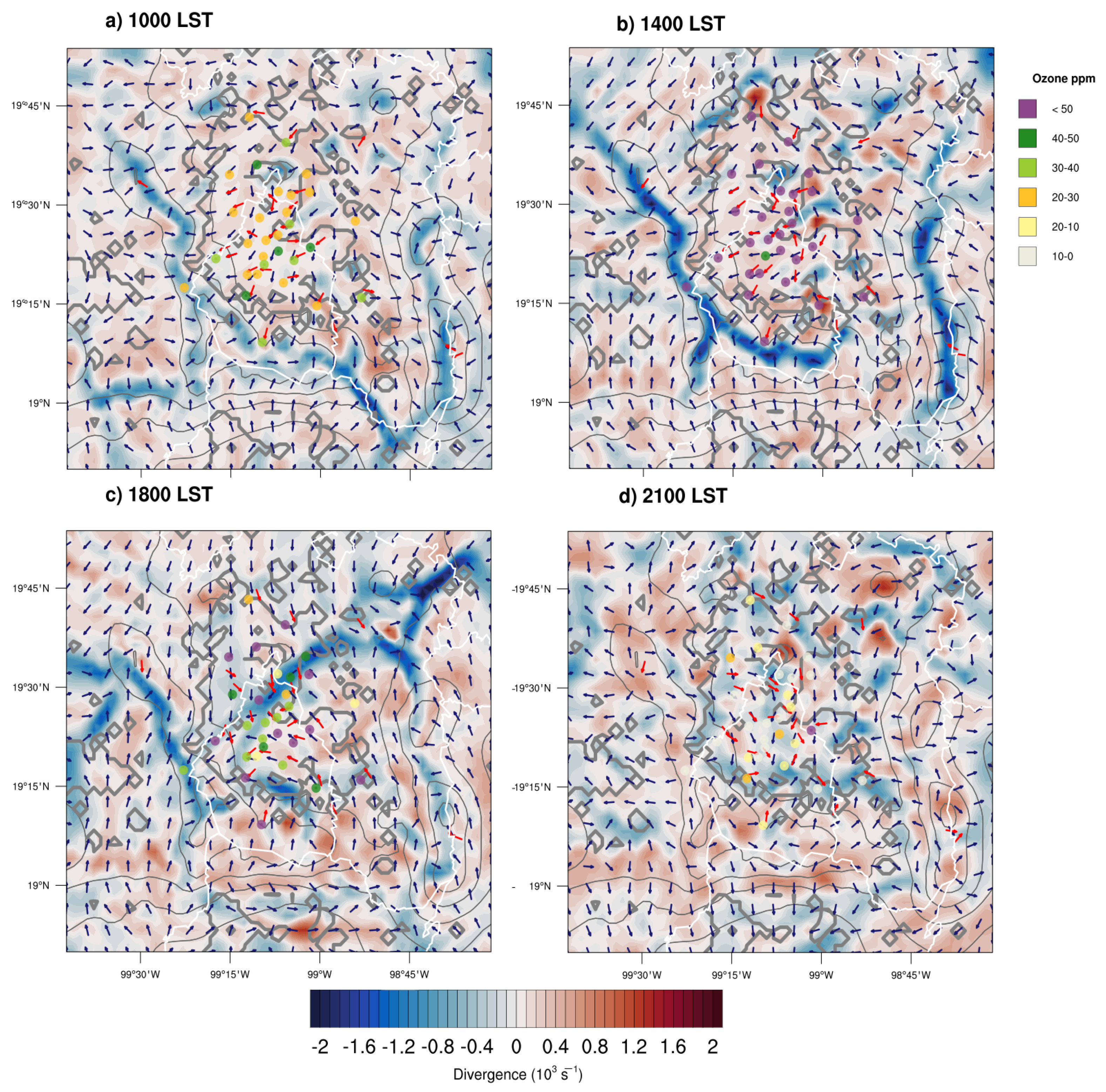

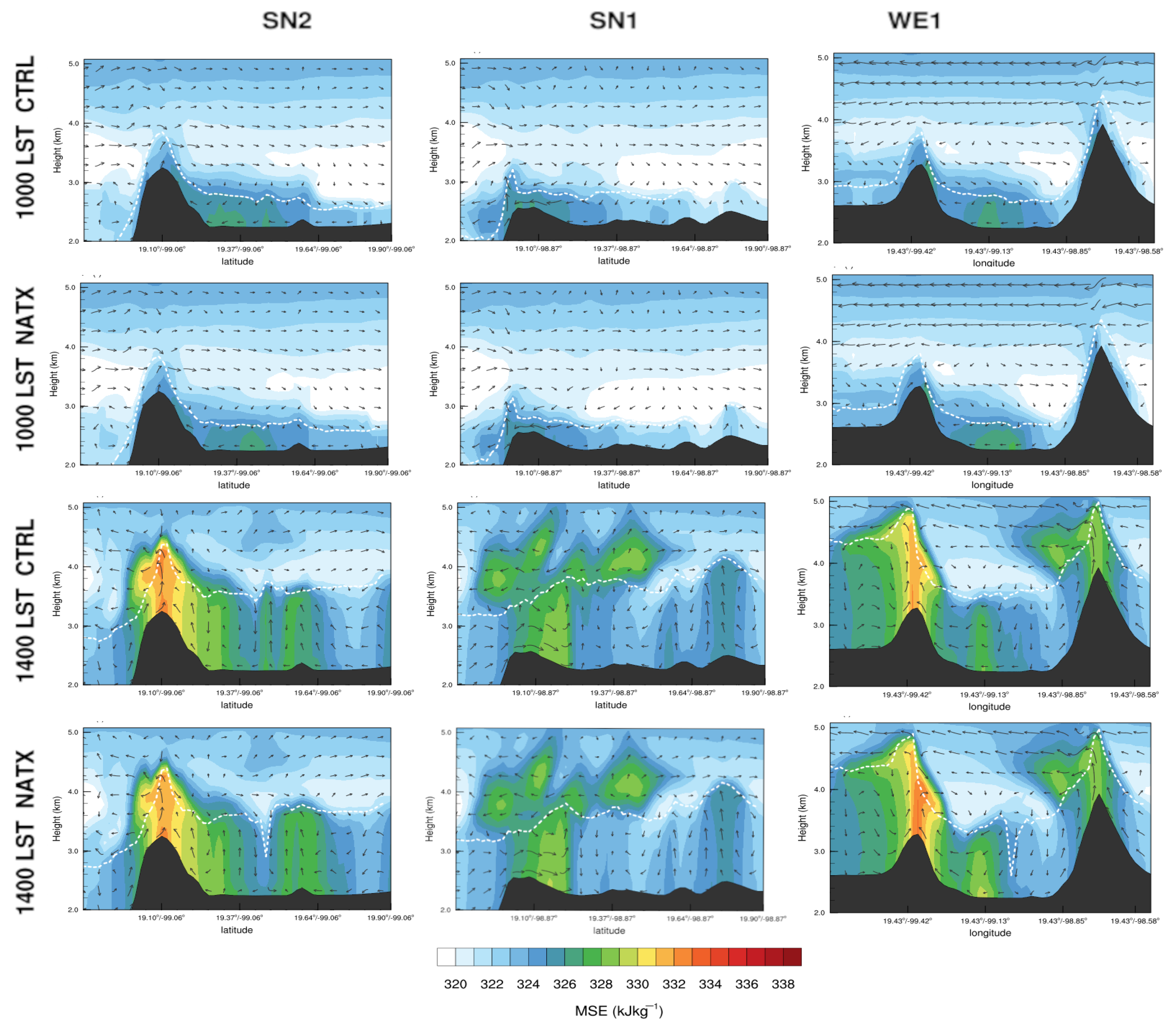
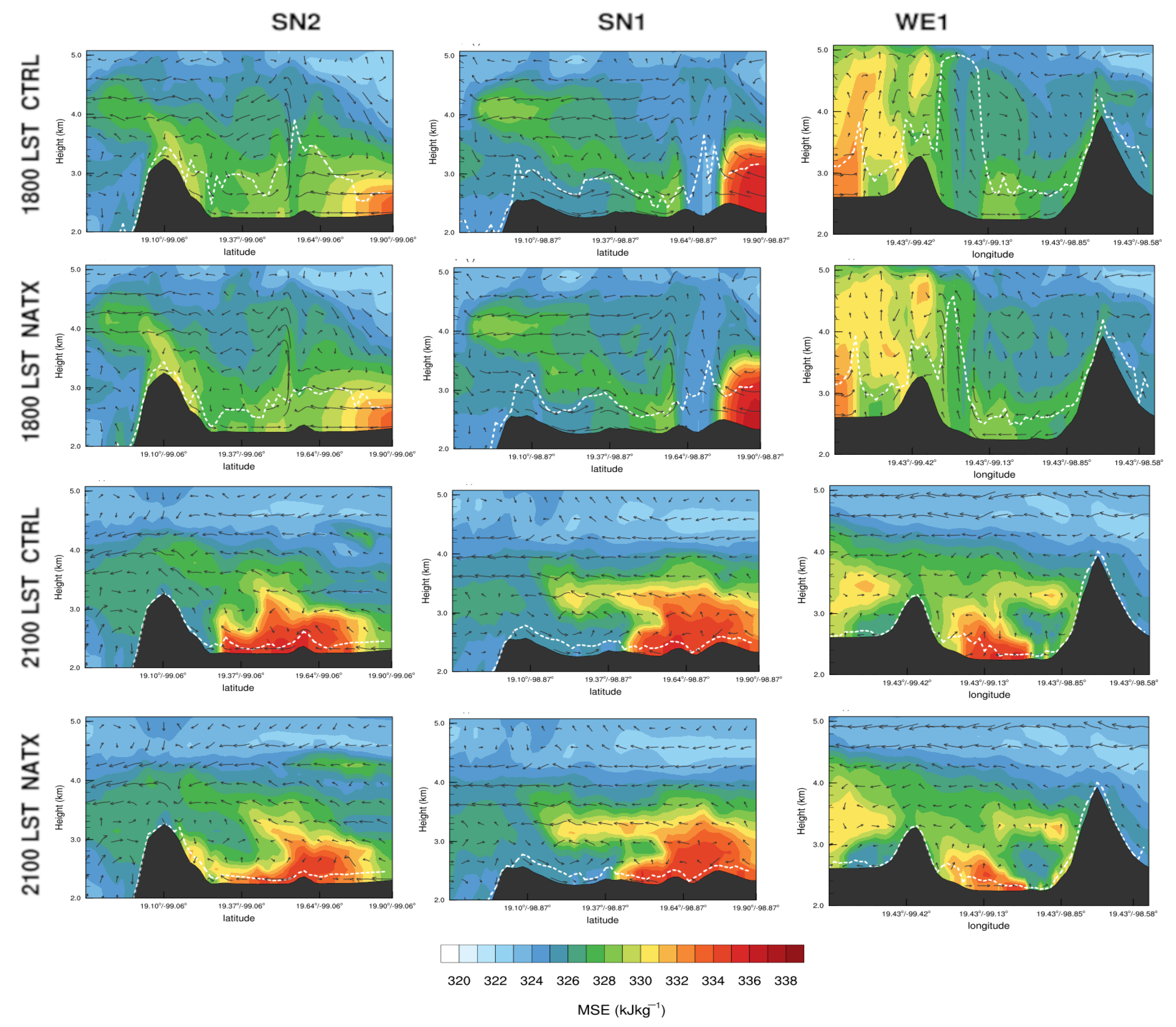

| Category USGS | Area(%) | Albedo% |
|---|---|---|
| Urban and built-up | 16.00 | 15.00 |
| Dryland cropland and pasture | 51.40 | 20.00 |
| Irrigated cropland and pasture | 6.60 | 20.00 |
| Cropland/woodland mosaic | 0.64 | 20.00 |
| Grassland | 0.66 | 23.00 |
| Shrubland | 0.61 | 22.00 |
| Deciduous broadleaf forest | 1.30 | 17.00 |
| Evergreen broadleaf forest | 4.50 | 12.00 |
| Evergreen needleleaf forest | 12.60 | 12.00 |
| Mixed forest | 4.20 | 14.00 |
| Water bodies | 0.43 | 8.00 |
| Herbaceous wetland | 0.05 | 14.00 |
| Barren or sparsely vegetated | 0.66 | 23.00 |
| Herbaceous tundra | 0.35 | 15.00 |
Publisher’s Note: MDPI stays neutral with regard to jurisdictional claims in published maps and institutional affiliations. |
© 2021 by the authors. Licensee MDPI, Basel, Switzerland. This article is an open access article distributed under the terms and conditions of the Creative Commons Attribution (CC BY) license (https://creativecommons.org/licenses/by/4.0/).
Share and Cite
Aquino-Martínez, L.P.; Quintanar, A.I.; Ochoa-Moya, C.A.; López-Espinoza, E.D.; Adams, D.K.; Jazcilevich-Diamant, A. Urban-Induced Changes on Local Circulation in Complex Terrain: Central Mexico Basin. Atmosphere 2021, 12, 904. https://doi.org/10.3390/atmos12070904
Aquino-Martínez LP, Quintanar AI, Ochoa-Moya CA, López-Espinoza ED, Adams DK, Jazcilevich-Diamant A. Urban-Induced Changes on Local Circulation in Complex Terrain: Central Mexico Basin. Atmosphere. 2021; 12(7):904. https://doi.org/10.3390/atmos12070904
Chicago/Turabian StyleAquino-Martínez, Lourdes P., Arturo I. Quintanar, Carlos A. Ochoa-Moya, Erika Danaé López-Espinoza, David K. Adams, and Aron Jazcilevich-Diamant. 2021. "Urban-Induced Changes on Local Circulation in Complex Terrain: Central Mexico Basin" Atmosphere 12, no. 7: 904. https://doi.org/10.3390/atmos12070904
APA StyleAquino-Martínez, L. P., Quintanar, A. I., Ochoa-Moya, C. A., López-Espinoza, E. D., Adams, D. K., & Jazcilevich-Diamant, A. (2021). Urban-Induced Changes on Local Circulation in Complex Terrain: Central Mexico Basin. Atmosphere, 12(7), 904. https://doi.org/10.3390/atmos12070904








